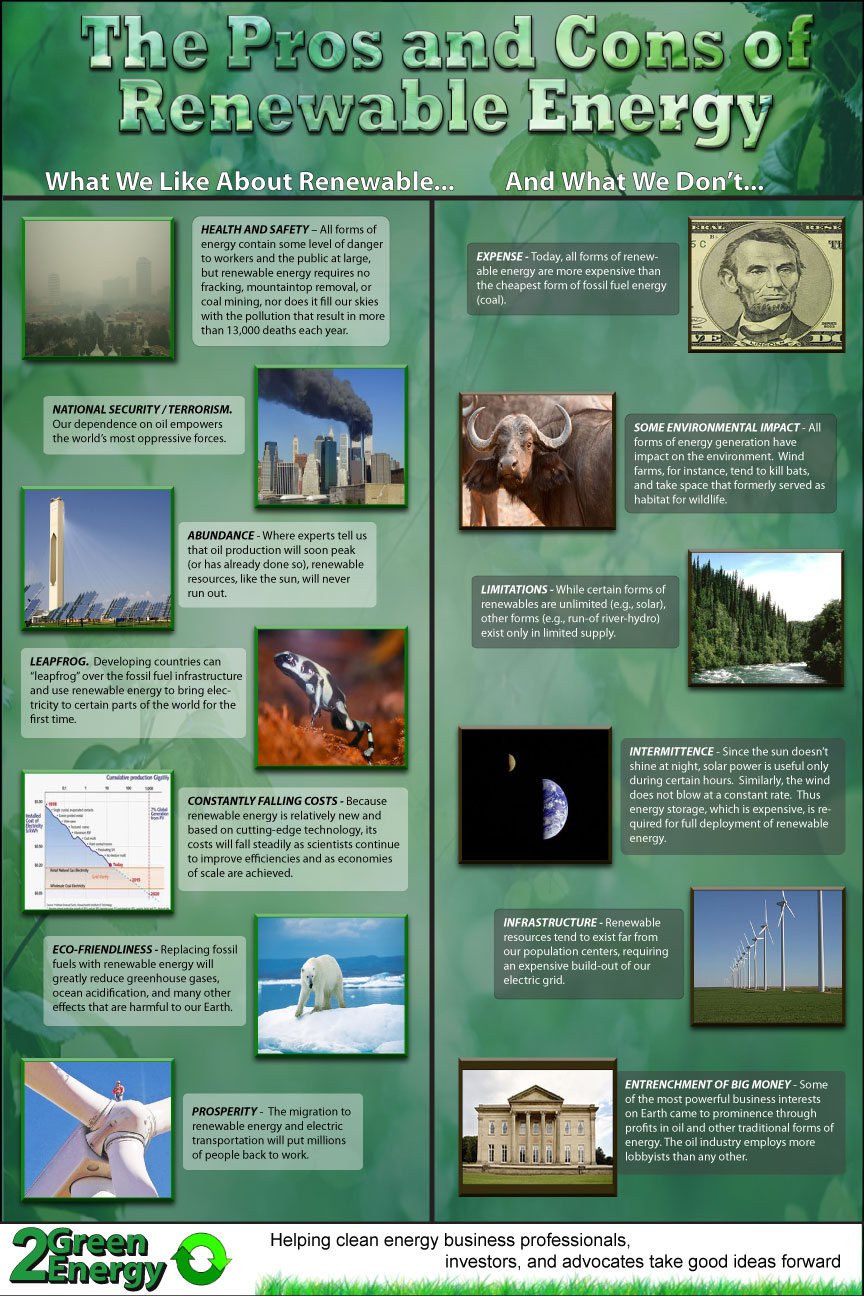Infographic: The Pros and Cons of Renewable Energy
Whenever I speak on renewable energy, I’m careful to leave my audience with a sense of the “tough realities.” We all want simple answers to our questions, but in the case of clean energy, none exist.
There are dozens of different flavors of solar, wind, biomass, hydro, and geothermal, each improving in terms of cost and efficiency, but at different rates. There are economic issues, as none of these flavors can compete with the dirtiest form of coal, if we don’t take into account the “externalities” like lung disease and environmental damage. And Lord knows there are political issues, where we have serious candidates for president of the U.S. who, if elected, boldly pledge to dismantle our Environmental Protection Agency and Department of Energy. If this occurs, it would effectively end the efforts of the largest economy on Earth to migrate away from fossil fuels and nuclear.
Here’s another in a series of infographics that attempts to put all this into perspective. Hope you enjoy.



Hello Craig,
Enjoyable indeed.
Hurdles are normal at least Iam used to it by now/ Been working withthe moral support of a canadian wellwisher since the past 25 years or so onThermal Solar applications. ABNORMALY HELPFUL SCENARIO WOULD BE TO HAVE A PRESIDENT at the White House who is our well wisher. The Govt of India has allocated funds worth Millions of DOLLARS for solar PV lighting of over 60,000 villas in each state . This after 25 years of hesitations. So I would consider your work as pioneering . We just have to keep up our rhythmic rhetoric about the advantages of RENEWABLE ENERGY and keep educating the masses on Global Warming.
Regards
shrinivas
Hi Craig,
If I were comparing pros and cons of alt energy I would remove intermittence as a Con.
Although I’m not a fan of solar, technology exists to sotre the latent energy in batteries and converting the gained energy to hydrogen.
It should be reminded that Geothermal works 24/7, has a longer life of use and is hidden beneath the surface.
That is a huge advantage for commercial and residential applications.
I’m still confused why the alt energy biz continues to discount geo technology as being the green choice of last resort when promoting the industry.
I can only assume it is that way because geo is the one technology that requires the least replacement so the repair & replace market is too small to pursue.
Sincerely, Tim
It’s true that geothermal is mot intermittent (which is why I pointed to solar and wind). I struggled with how to present all this one page, make it easy to read, accurate, but not oversimplified.
I have a funny story that involves my grandfather and his farm in Sheldon, Vermont. About 50 miles from Montreal. My famly are from frace. 1620 or so. They were creative, bold and inventive. I was 8 years old, and winter vacations there and summer was haying and helping granpa, Luchian Menard. I notice a copper pipe which ran under a rather large menure pile. It went into the barn. I traced it to a large tank with a very small pump. The pump was running to other smaller copper pipes going in different directions around the barn. i felt the pipe and it was quite hot. I asked gramps…why are you heating the poop pile. He laughed. I’m not he said. It keeps the milk room from freezing and its free heat. He explained it to me as if he was a scientist. But, more than that, he had common sense.
Cut from the same cloth, my company which deals with Vortex technologies and innovations, came up with a very new and very green propulsion system that can eliminate the jet drive and the propeller. I sent information to this web-site a week ago and await discovery. So far John Deere and Catipiller are interested. Viking yacht’s chief engineer has recieved a first package which includes carbon footprintand emissions reductions and fuel savings vested in this invitation.
The vortex seadrive 3000 and the 4000 models, we project, will reduce the expense woes of water transportation and the working fishing fleets long term. World wide, its in the billions saved. The plus side is that it is a now wake, no waste system. It uses the Eulerian method of vorticity confinment. Natures partner to natural energy production. We have two more innovations on the drawing board for next year. We are excited and a new company. The world need fresh ideas and new, simple approach, that everyone can benifit from. We will be happy to keep this site posted as to future progression. James P. Beyor. founder.
Craig, several factors are excluded in your review.
1) 24/7 energy demand vs intermittent not-always-available RE supplies. Major reason modern storage-free grid-tied RE requires conventional energy grid always-on in background is because almost no storage-free RE is able to replace the almost continuous output of nukes and coal-fired gens. This is both about 24/7 consumer and business demands AND lack of storage. My office has operated over 10 yrs off-grid with PVs, so that is possible. But I achieve that with a 10-day power supply in batteries. Yes, that adds to RE cost. But so does operating the conventional coal and nuke gens behind storage-free RE. It is erroneous to quote RE-only prices when RE requires background gen for backup.
2) Modern power demand is wasteful, inefficient and too often overly guzzling in nature, based on low prices of most conventional power compared to RE replacement with adequate storage. No serious strategy to convert to RE, or more pointedly, away from coal and nuke, is serious enough without significant reductions to our energy wasting, inefficiency and guzzling.
3) Most grid-tied RE does not avoid or eliminate emissions at the same rate as the supplied RE power. In other words, even if I’m using 100% RE during a mid-day when it’s sunny, if there’s a conventional generator on in the background just in case a cloud rolls over my location and I need conventional energy backup, then I am “demanding” conventional energy emissions even when 100% RE-using. Assess emissions honestly and at the source, not at user.
This is a very nice little summary. Of course, as a summary it won’t include all the factors and details (as some of the responses pointed out).
I very much like that you’ve included a link to your great “externalities” video and I hope people click and watch and learn.
Another graphic to summarize all the most important and little recognized of these many hard and soft costs fossil enrgy firms have so successfully externalized would be especially useful to the discussion – particularly as they offset (and even overturn) the cash-cost increase to move to RE, even as compared to include a fully holistic accounting of what costs RE might externalize.
Looks nice. Kind of curious on the target audience of such graphics. Simplifications of whatever kind are usually based on the best estimate regarding the audience. Something someone would do at an Earth Day booth or ?
A very minor point is the hydro. California does not consider hydro as RE when accounting for the various types of supply, and hydro is decreasing year over year in any case.
The other observation I’ve noticed the lay public being aware of, is the utility scale RE generation vs. the commercial scale rooftop solar vs. the highly distributed. It may have come about due to the occasional news item about transmission line rights of way and environmental impact that we see every few months.
Yes, I should have mentioned that the purpose of these infographics is to introduce new people to the subject. Also, as you noticed, the task of trying to get all these ideas in one graphical element does require some level of oversimplification.
Hi Craig,
Why don´t you consider OTEC-Ocean Thermal Energy Conversion?
Best,
Vicente
Rio
Oh, I consider it — in a big way. I have a meeting with these guys next week when I’m back East; I’m really looking forward to it. http://www.otecorporation.com/index.html.
Hi!Craig,
moral values aside in our part of the world – Pakistan -we seem to have bogged down with the weight of whole of this renewable energy and the clean environment etc .
There seems to be something which is keeping us from reaching that speed where we could say that we are now off the ground with renewables.
Hey! I am not complaining but looking at this whole scenario in our part of the world with this latest ever evolving thought of yours – The Pros and Cons of Renewable Energy.
Yes ours is a third world country agreed but look India is there they have done so much and they still plan to do much more.
Could you advise as to how we – the people who understand renewable , green energy etc – could convince the captain of the ship ( leaders) for some action which could really bring sustainable renewable energy related activity on ground .
In short we need help.
I like the approach, but fear that today when you try to be balanced, it is like that Far Side cartoon the dog where all he hears is his name. (http://stephhicks68.hubpages.com/hub/Gary-Larson)
There are people who see that we are in early days on renewable energy as a widespread power source and thus have to learn and grow. There are many others who will simply ignore the left side of your page and simply take the right side and say, “Even people for Renewables think…”
You need to start much left of middle if you want to move the needle for most of America.